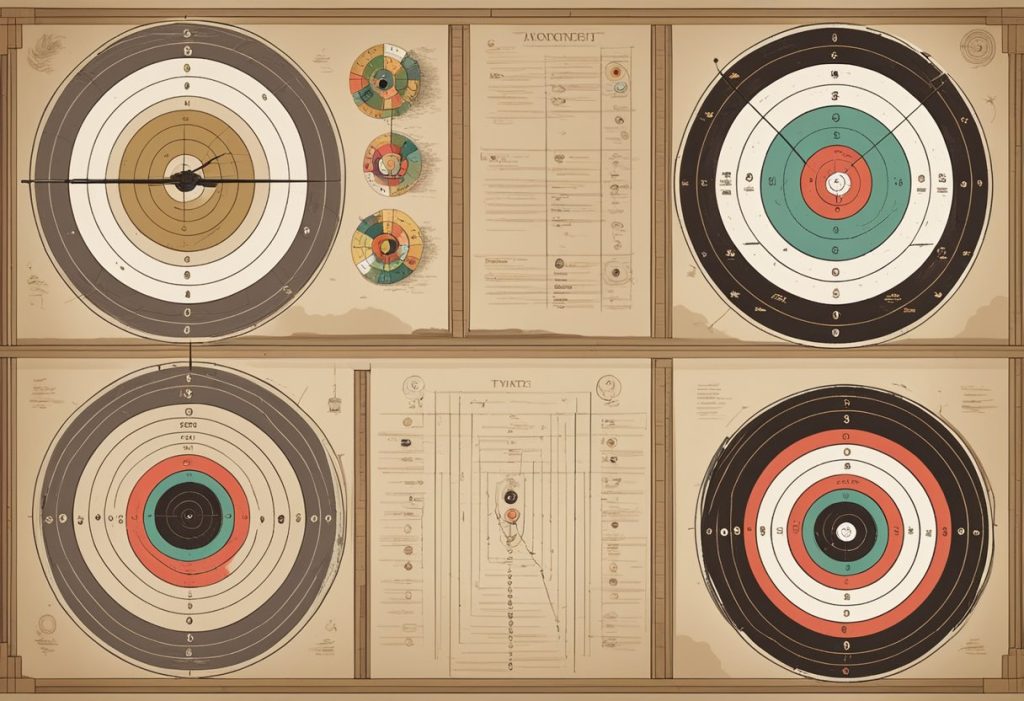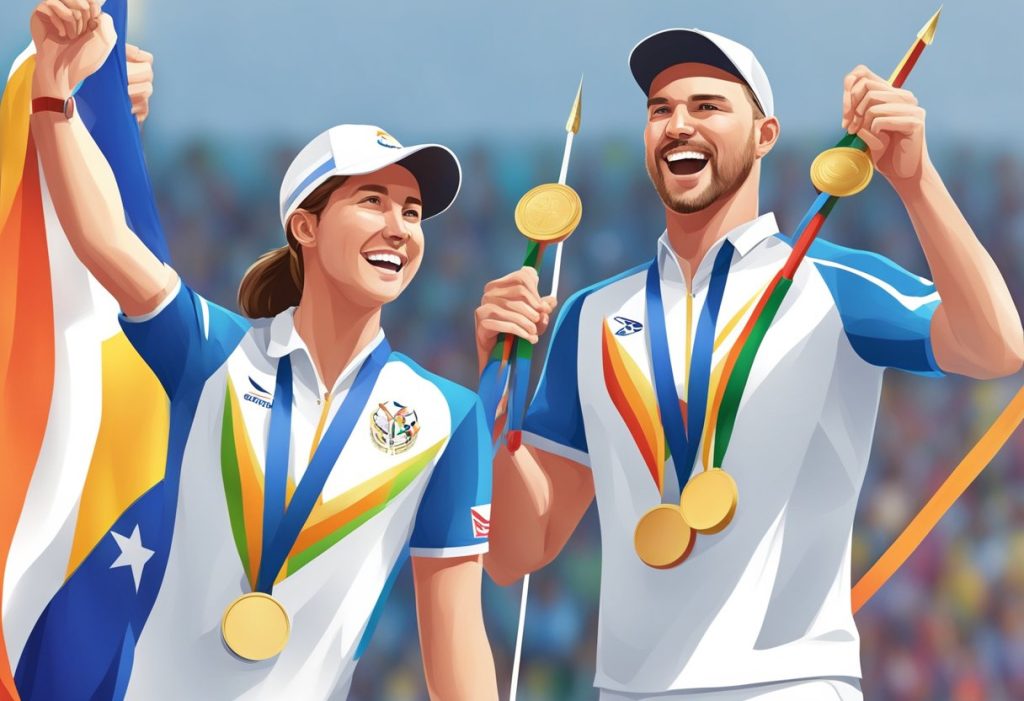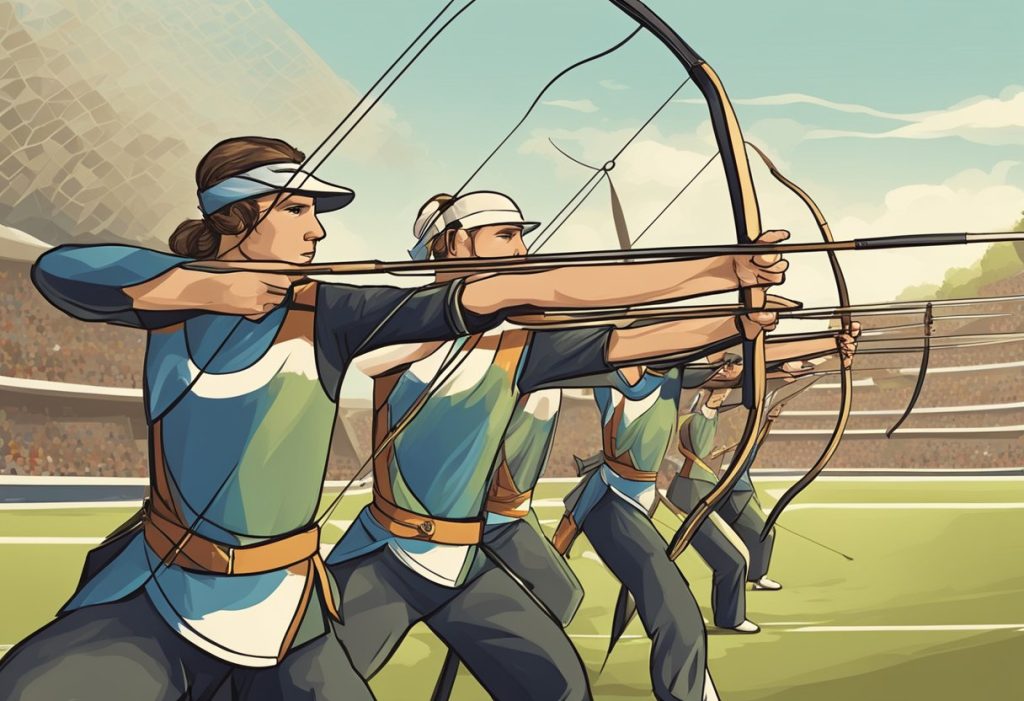Olympic archery has played a significant role in the history of the Olympic Games, with its roots dating back to the early 20th century. The sport first made its Olympic debut at the Paris Games in 1900, showcasing the skill and precision of archers from around the world. Over the years, the sport has undergone several changes and innovations, such as the introduction of team events and format changes. Archery has grown in popularity and continues to be a captivating spectacle for athletes and spectators alike.
Historical performances in Olympic archery have left their mark on the sports world, as the dedication and prowess of the athletes are put to the test in various events. From its early era between 1900 and 1920, to the modern era that began with its Olympic comeback at the 1972 Munich Olympics, archery has showcased unforgettable moments and milestones.
With the inclusion of precise skill, mental strength, and the undeniable spirit of competition, Olympic archery remains an integral part of the Olympic Games, inspiring athletes and sports enthusiasts for generations to come.
Evolution of Olympic Archery

Early Olympic History
The sport of archery has a long history in the Olympic Games, making its first Olympic games appearance at the Paris 1900 Olympics. The initial appearance consisted of seven disciplines that were contested at varying distances. These disciplines included events such as Au Cordon Doré and Au Chapelet, which were contested at 33m and 50m distances.
Four years later, at the St. Louis 1904 Summer Olympics, six archery events were organized, with three dedicated for men and three for women. This Olympics also marked the introduction of team competitions and women’s individual competition.
The first official Paralympic Games, as we know them today, were held in 1960 in Rome, Italy. However, the journey started earlier:
- 1948: Sir Ludwig Guttmann organized the Stoke Mandeville Games for British World War II veterans with spinal cord injuries in England. This is considered the precursor to the Paralympic Games.
- 1952: Athletes from the Netherlands joined the British for the Stoke Mandeville Games, marking the beginning of international participation.
- 1960: The first official Paralympic Games, featuring 400 athletes from 23 countries, were held in Rome six days after the closing ceremony of the Olympic Games. This event solidified the international nature and Olympic-style format of the Paralympic Games.
So, while the Paralympic movement has roots as early as 1948, the first official Paralympic Games as we know them today took place in 1960.
Introduction of Contemporary Rules
A modern era for Olympic archery began in 1972, when the sport became a permanent fixture in the games. This reintroduction followed the establishment of standard rules of archery by the Federation Internationale de Tir a L’Arc (FITA), introduced to ensure a unified global competition format. This new format, known as the FITA Round, consisted of multiple shooting distances with separate scoring systems.
The Olympic Round format was introduced in 1992, bringing an exciting new head-to-head elimination process to the games. Archers competed in individual matches, where their tournament progress depended on winning each round. This format significantly increased the intensity and entertainment value of archery competitions.
Recent Changes and Formats
Over the years, archery has continued to evolve in the Olympic Games. One of the most recent and notable changes occurred at the Olympic Games Tokyo, which introduced a mixed team event format. This event required an equal participation of male and female archers, promoting a spirit of unity and inclusivity within the sport.
Similarly, recent Olympic competitions have featured a team ranking round where teams are ranked based on their combined scores, followed by an elimination round. This system ensures that the teams and individual archers advance through the competition based on their performance in earlier rounds.
As Olympic archery continues to evolve and adapt to modern formats and standards, the sport remains a testament to the skills and dedication of the athletes participating and the rich history it holds at the Olympic Games.
Performance and Records
Notable Olympic Records
Several outstanding Olympic records have been set in the history of archery. South Korean archer An San set a new Olympic record in women’s archery at the Tokyo 2020 Olympic Games, scoring 680 points in the ranking round. On the other hand, Belgian archer Hubert Van Innis holds the title for the most Olympic medals in archery, with a total of 9 medals (6 gold and 3 silver) earned in the 1900 and 1920 Olympics.
Breakthrough Performances
Some breakthrough performances in Olympic archery history include Justin Huish’s double gold victory for the USA in the 1996 Atlanta Olympics. Huish won gold in both the individual and team events, making a significant contribution to the US archery team’s achievements. Another remarkable performance was seen in the 1988 Seoul Olympics, where Kim Soo-Nyung secured four gold medals, one silver, and one bronze for Republic of Korea.
Country-Specific Achievements
In Olympic archery, specific countries have demonstrated dominance throughout history. South Korea has been particularly impressive, winning 27 out of 39 gold medals in events since 1984. This country’s success is reflected in outstanding archers like An San and Kim Soo-Nyung, who have significantly contributed to Korea’s gold medal count.
The USA is another country with a commendable history in Olympic archery. From 1904 to the present, they have consistently featured on the list of Olympic medalists in archery. In addition, Italian archers have also made a mark in Olympic archery, with Marco Galiazzo and Mauro Nespoli capturing medals for their country at the Athens 2004 and London 2012 Olympic Games, respectively.
Olympic Archery Competition Structure

Archery has been a part of the Summer Olympics since its early era in 1900, 1904, 1908, and 1920, re-establishing its position as a permanent fixture in 1972. The competition at the Olympic Games is regulated by the World Archery Federation and follows a detailed structure that includes qualification rounds as well as final rounds and medal matches, primarily for recurve archery.
Qualification Rounds
The Olympic archery competition begins with the ranking round, where athletes shoot a total of 72 arrows, determining their rankings and seedings. This round is crucial as it not only impacts the athletes’ positions in the single-elimination bracket but also serves as the qualification process for the team events if they have not already qualified through the World Archery Championships.
The archers shoot their arrows in ends, where each end consists of six arrows. The rankings are based on the total scores obtained from all the arrows shot during the ranking round.
Final Rounds and Medal Matches
Once the qualification rounds are completed and the athletes are seeded, they advance to the elimination rounds. In these rounds, archers face each other in a single-elimination bracket, where the winner advances to the next round and the loser is eliminated from the competition. The bracket narrows down until there are only four remaining contenders.
The two winners of the semi-finals proceed to the gold medal match, while the two semi-final losers compete against each other for the individual silver and bronze medals. Additionally, there is a competition for team gold, silver, and bronze medals based on the teams’ performances throughout the tournament.
In conclusion, the Olympic archery competition consists of a meticulously designed structure that showcases the skill and precision of the athletes. The competition begins with a crucial qualification round, followed by the exhilarating elimination rounds, ultimately leading to the highly anticipated medal matches.
Techniques and Equipment – Compound Bow
Bow Types and Selection
In Olympic archery, the recurve bow is the only type of bow used. It consists of a riser, which is the part the archer holds, and limbs that extend from the riser. Recurve bows are chosen for their precision and consistency in performance, making them suitable for competitive archery.
Wood was once a popular material for bows, but in modern Olympic competitions, more advanced materials like carbon and aluminum are preferred for their durability and lightweight properties.
Scoring Systems
Several scoring systems have been used in Olympic archery throughout history. Below is a summary of three notable formats:
- Double Columbia Round: This scoring system was used in the early days of Olympic archery. It involved shooting 96 arrows over different distances, with men shooting at 50, 40, and 30 yards, and women at 40, 30, and 20 yards.
- Grand FITA Round: Introduced by the International Archery Federation (FITA, now World Archery), the Grand FITA Round established a standardized scoring system and consisted of shooting 144 arrows at four distances (90, 70, 50, and 30 meters for men; 70, 60, 50, and 30 meters for women).
- Double National Round: Similar to the Double Columbia Round, the Double National Round involved shooting 96 arrows but at longer distances (100, 80, and 60 yards for men; 80, 60, and 50 yards for women).
Since the reintroduction of archery into the Olympics in 1972, the scoring format has evolved to accommodate both individual and team events. Individual events require archers to shoot 72 arrows in the ranking round, with scores determining seeding for the knock-out elimination matches. In team events, the combined scores of each team’s archers determine the rankings, with teams then competing head-to-head in elimination-style matches.
Throughout Olympic archery history, the equipment and scoring systems have seen significant changes, resulting in the modern techniques and methods used today. The recurve bow remains the staple choice for Olympic archers, and the scoring system has further evolved, allowing for team events and memorable individual performances.
Significant Olympic Athletes in Archery

Pioneers of Olympic Archery
One of the early pioneers of Olympic archery was Hubert Van Innis. He remains one of the most successful Olympic archers of all time. Competing in the 1900 and 1920 Olympics, Van Innis won a total of nine medals, including six golds and three silvers. Despite the 20-year gap between his Olympic appearances, Van Innis’ skill and dedication to the sport remained undiminished.
Another notable pioneer was Doreen Wilber, an American archer who won the gold medal in the women’s individual event at the 1972 Munich Olympics. Wilber helped pave the way for future female archers and became a role model for many aspiring athletes.
Modern Era Champions
The modern era of Olympic archery has seen numerous remarkable talents emerge. Darrell Pace is one such athlete. Considered by many as one of the best archers of all time, Pace won a total of four Olympic medals, including two individual golds in 1976 and 1984, as well as team silver medal (1988) and bronze (1984) medals.
Another modern era champion is An San, a South Korean archer who made history at the 2020 Tokyo Olympics by becoming the first archer to win three golds in a single Olympic Games. An San’s achievements showcase the incredible talent present in today’s generation of archers.
The United States has also seen its share of exceptional archers. In the 1996 Atlanta Olympics, Rod White, Butch Johnson, and Justin Huish formed the US team, which won the gold medal in the men’s team event. Their success highlighted the dedication and hard work of these talented athletes.
In conclusion, Olympic archery has been graced with numerous exceptional athletes, both in its early days and the modern era. These pioneers and champions of the sport have pushed the boundaries of talent and set new standards for future generations to strive for.
Olympic Venues and Host Cities

Iconic Olympic Venues
One of the most memorable Olympic archery venues was the Sambódromo in Rio de Janeiro, which hosted the archery competitions during the 2016 Summer Olympics. The Sambódromo is primarily used for the famous Rio Carnival but transformed into an archery arena for the Olympics, providing a unique atmosphere for the athletes and spectators alike.
Another iconic Olympic archery venue is the Lord’s Cricket Ground in London, which hosted the archery events during the 2012 Summer Olympics. This historic venue, primarily known for cricket, provided a spectacular backdrop for the competition, as the archers stood in front of the famous Pavilion and competed on the hallowed grounds usually reserved for cricket matches.
Historical Host Cities
Since the introduction of archery to the Olympic Games in 1900, several host cities have contributed to the sport’s Olympic history. Paris, the first city to host archery at the Olympics, initiated a long-lasting tradition that would see a multitude of host cities providing venues for archery competitions.
Notable host cities include:
- Paris (1900): Archery made its debut at the Bois de Vincennes during the 1900 Summer Olympics, and Paris is set to host the Olympics once again in 2024.
- London (1908, 2012): London has hosted the archery events twice, first in 1908 at the White City Stadium, and later in 2012 at Lord’s Cricket Ground.
- Athens (2004): The Panathinaiko Stadium in Athens, a historic location that hosted the first modern Olympic Games in 1896, held the archery events for the 2004 Summer Olympics. This venue was a distinctive choice, tying the sport to the long and rich history of the Olympic Games.
- Tokyo (2020): Most recently, Yumenoshima Park Archery Field in Tokyo hosted the archery events in the 2020 Summer Olympics, providing contemporary facilities for the athletes while reflecting the city’s futuristic urban landscape.
Throughout the years, Olympic host cities have provided exceptional venues for archery, creating an exciting and memorable experience for both the participants and fans of the sport.
Cultural and Political Influence on Olympic Archery
The resurgence of archery in the Olympics can partially be attributed to cultural influences and international politics. For instance, South Korea’s dominance in the sport since 1984 derives from their strong cultural background in traditional archery, and their role in the political landscape^1^. The South Korean team has won 27 out of 39 gold medals since 1984 making them a significant force in Olympic archery.
The preparation for archery events during the Olympics have not been without political influences. The Games of the XX Olympiad in Munich in 1972, saw the re-introduction of archery in the Olympic program after being absent for more than 50 years. Increasing standardization and support from international organizations like the World Archery Federation (WA; formerly FITA), have also played a significant role in the growth and development of the sport over the years.
Some notable milestones in Olympic archery history include:
- The inclusion of women’s events in 1904, making archery one of the first sports to include women’s events.
- The introduction of mixed teams event, marking the first time in Olympic history to have mixed-gender teams compete for a gold medal.
From a cultural perspective, the traditional art of archery, popular in many cultures around the world, boosts the sport’s overall appeal. From the Mongolian horse archers to the English longbowmen, each culture’s contribution to the sport’s heritage has shaped its Olympic presence. Today, Olympic archery combines both tradition and modern technology, reflecting the influences of various cultures and continually evolving regulations.
In conclusion, the cultural and political landscape has had a significant influence on Olympic archery throughout its history. The continual evolution of the sport on the global stage is a testament to its rich heritage, widespread appeal, and its ability to adapt within diverse cultural contexts and political environments.
Facts and Trivia

Olympic Archery Fun Facts
- Archery has a long and split history in the Olympic Games, with two distinct periods: the early era and the modern era. The sport featured in the Olympic Games during the early era, which included 1900, 1904, 1908, and 1920. During this period, archery was one of the first sports to include women’s events, in 1904.
- In the modern era, archery made a triumphant return to the Olympics in 1972 and remains an integral part of the Games today.
- An interesting trivia about Olympic archery is the change in the number of arrows used throughout history. In the 1900 Olympics, archers shot 120 arrows per round, which eventually reduced to 72 arrows by the 1988 Seoul Olympics. Nowadays, the recurve archery competition follows 70 meters distance with 72 arrows.
- Regarding team events, the 1920 Olympics in Antwerp, Belgium, introduced 10 events, which today include men’s and women’s individual competitions, as well as men and women’s team events. The mix of events in Olympic archery has also changed, with individual and team events offering medals for the top three performers.
- The youngest archer to win an Olympic gold medal was South Korea’s Kim Soo-nyung, who at just 17 years of age, captured the women’s individual title at the 1988 Seoul Olympics.
- Additionally, 1908’s gold medalist, Queenie Newall from Great Britain, remains the oldest Olympic archery champion at the age of 53.
- Bronze medal trivia: In the 1984 Los Angeles Olympics, Kim Jin-Ho from South Korea became the first archer from her country to win an Olympic medal, securing bronze in the women’s individual event. Since then, South Korea has emerged as a dominant force in the sport.
By delivering these facts and trivia, we hope to showcase the rich history and interesting milestones of Olympic archery.
